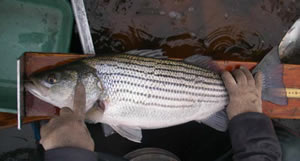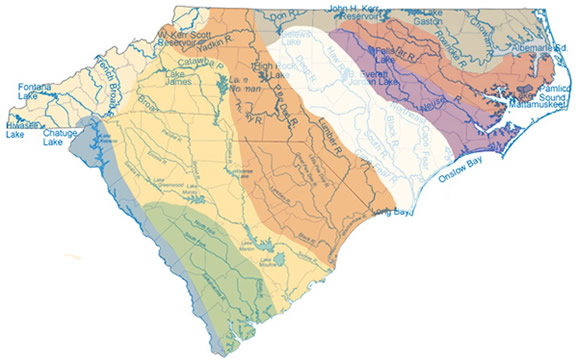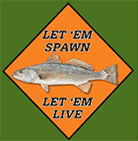Striped Bass Genetic Structure

In the Carolinas, striped bass, Morone saxatilis, are found in all major river drainages and generally remain in rivers year-round as compared to more northerly populations, which spend a large part of their life in the sea. South Carolina’s striped bass populations began to decline in the 1970s and the State began to stock rivers in 1984 to enhance their population numbers. At the time, it was assumed that striped bass in South Carolina represented a single genetic population and the State stocked juvenile bass reared from Santee-Cooper parents into all systems in need of enhancement. Managers in South Carolina began to suspect that populations actually represented different stocks by the mid-1990s and stopped the practice of stocking Santee-Cooper offspring into other watersheds. Since the Santee-Cooper system experiences high levels of recreational fishing pressure, stocking to support the population has continued (fig. 1).
In order to ensure responsible stocking of a species, managers must understand how populations are connected in order to identify appropriate management units. Over time, populations that are isolated from each other will become genetically different through random processes as well as becoming adapted or best suited for a particular habitat. If two populations, or rivers in the case of striped bass, have little to no migration of individuals occurring between them, stocking fish from one system into another creates an unnatural migration and could be deleterious to unique beneficial adaptations of the stocked system. Our study evaluated (1) if striped bass within South Carolina watersheds represent genetically unique populations and (2) if there are multiple populations within the Santee-Cooper System itself. We began using genetic tags in 2006 to be able to identify all striped bass that are stocked within South Carolina. These tags have been (and continue to be) used to evaluate stocking success as well as recruitment and population trends over time. However, the genetic data that is collected during these evaluations can also be used to identify genetic populations.
The genetic analyses show that the Santee-Cooper System contains one population of striped bass from the Congaree/Wateree Rivers to the Atlantic Ocean indicating that fish, both stocked and wild, move freely throughout the system. These results support the current practice of capturing fish, spawning them, and releasing offspring throughout the original system of capture, since no matter where broodstock are captured or offspring are released, they are all part of the same population. We have also found that the Savannah River, ACE Basin, and Santee-Cooper System each contain a distinct striped bass population and these populations are all different from striped bass in North Carolina. While we have not had the opportunity to evaluate samples from the Pee Dee River, it is likely that it contains a distinct striped population given biologists rarely stocked striped bass in the system in the ‘90s and no longer stocks it at all; however, the Pee Dee River still needs to be evaluated to confirm this assumption because (1) the most upstream reservoirs of the Pee Dee River in North Carolina have been stocked with Roanokestrain fish and (2) it represents a potential geographic and genetic connection between South and North Carolina populations.
A concern of stocking a system is that improper stocking could adversely affect the genetic health of a population within the system; therefore, we also investigated the genetic health of the populations across the Carolinas (fig. 2). The genetic health of a population is determined by the genetic diversity of a population. Genetic diversity can be thought of as a toolbox a population has— the more tools in the toolbox the more problems a repairman can fix; similarly, the higher the diversity of a population the more stressors or problems the population can withstand (such as higher summer temperatures the State is experiencing). With the exception of the Savannah River, all other river systems observed in the Carolinas are considered to be genetically healthy. The Savannah River, while not at an ideal level of health, is still at non-threatening levels of genetic health. Of particular interest is the Santee-Cooper System, as it is currently the only system stocked by South Carolina biologists. This system has good genetic health, indicating that stocking is done responsibly.

Our investigation has provided evidence that each river system within South Carolina contains genetically unique populations and therefore, our current stocking of striped bass is being conducted in accordance with Responsible Approach protocols. By stocking only the Santee-Cooper System, managers have preserved the genetic uniqueness of the other river systems allowing striped bass populations within those systems to maintain their biological adaptations. Additionally, the stocking techniques employed by managers ensure a genetically healthy system.



